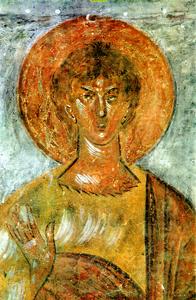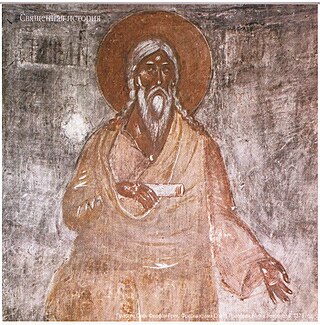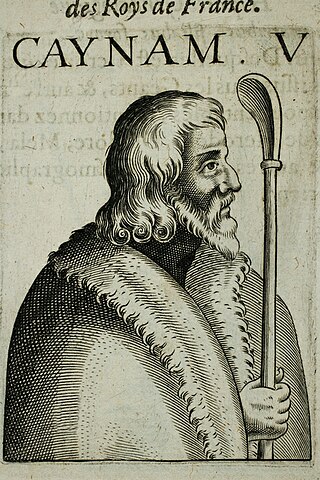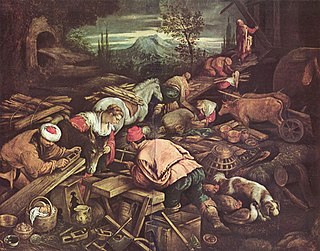
Abel is a biblical figure in the Book of Genesis within the Abrahamic religions. Born as the second son of Adam and Eve, the first two humans created by God, he was a shepherd who offered his firstborn flock to God as a religious offering. God accepted Abel's offering but not the offering of his older brother Cain, leading Cain to stone Abel to death out of jealousy. This act marked the first death in biblical history, making Abel the first murder victim.

Seth, in the Abrahamic religions, was the third son of Adam and Eve. According to the Hebrew Bible, he had two brothers: Cain and Abel. According to Genesis 4:25, Seth was born after Abel's murder by Cain, and Eve believed that God had appointed him as a replacement for Abel.

Cain is a biblical figure in the Book of Genesis within Abrahamic religions. He is the elder brother of Abel, and the firstborn son of Adam and Eve, the first couple within the Bible. He was a farmer who gave an offering of his crops to God. However, God was not pleased and favored Abel's offering over Cain's. Out of jealousy, Cain killed his brother, for which he was punished by God with the curse and mark of Cain. He had several children, starting with Enoch and including Lamech.

The Book of Jubilees is an ancient Jewish apocryphal text of 50 chapters, considered canonical by the Ethiopian Orthodox Tewahedo Church, as well as by Beta Israel. Jubilees is considered one of the pseudepigrapha by the Eastern Orthodox, Catholic, and Protestant churches. Apart from the Beta Israel community, the book is not considered canonical within any of the denominations of Judaism.

In the biblical Book of Genesis, Cain and Abel are the first two sons of Adam and Eve. Cain, the firstborn, was a farmer, and his brother Abel was a shepherd. The brothers made sacrifices, each from his own fields, to God. God had regard for Abel's offering, but had no regard for Cain's. Cain killed Abel and God cursed Cain, sentencing him to a life of transience. Cain then dwelt in the land of Nod, where he built a city and fathered the line of descendants beginning with Enoch.

Cain and Abel are a pair of characters from DC Comics based on the biblical Cain and Abel. They are key figures in DC's "Mystery" line of the late 1960s and 1970s, which became the mature-readers imprint Vertigo in 1993.

The Conflict of Adam and Eve with Satan is a 6th-century Christian extracanonical work found in Ge'ez, translated from an Old Arabic original which is translated from a Syriac source, namely Cave of Treasures.
The Life of Adam and Eve, also known in its Greek version as the Apocalypse of Moses, is a Jewish apocryphal group of writings. It recounts the lives of Adam and Eve from after their expulsion from the Garden of Eden to their deaths. It provides more detail about the Fall of Man, including Eve's version of the story. Satan explains that he rebelled when God commanded him to bow down to Adam. After Adam dies, he and all his descendants are promised a resurrection.

Kenan is an Antediluvian patriarch first mentioned in the Book of Genesis in the Hebrew Bible.
"Generations of Adam" is a genealogical concept recorded in Genesis 5:1 in the Hebrew Bible. It is typically taken as the name of Adam's line of descent going through Seth. Another view equates the generations of Adam with material about a second line of descent starting with Cain in Genesis 4, while Genesis 5 is taken as the "generations of Noah".

The wives aboard Noah's Ark were part of the family that survived the Deluge in the biblical Genesis flood narrative from the Bible. These wives are the wife of Noah, and the wives of each of his three sons. Although the Bible only notes the existence of these women, there are extra-biblical mentions regarding them and their names.

Adam is the name given in Genesis 1–5 to the first human. Adam is the first human-being aware of God, and features as such in various belief systems.

Eve is a figure in the Book of Genesis in the Hebrew Bible. According to the origin story of the Abrahamic religions, she was the first woman to be created by God. Eve is known also as Adam's wife.

Adam, in Islamic theology, is believed to have been the first human being on Earth and the first prophet of Islam. Adam's role as the father of the human race is looked upon by Muslims with reverence. Muslims also refer to his wife, Ḥawwāʾ, as the "mother of mankind". Muslims see Adam as the first Muslim, as the Quran states that all the Prophets preached the same faith of Islam.

Adam and Eve, according to the creation myth of the Abrahamic religions, were the first man and woman. They are central to the belief that humanity is in essence a single family, with everyone descended from a single pair of original ancestors. They also provide the basis for the doctrines of the fall of man and original sin, which are important beliefs in Christianity, although not held in Judaism or Islam.
There are many Biblical figures which the Qur'an names. Some, however, go unnamed in the Qur'an, but are referenced or referred to in the hadiths, tafsirs, literature or seerah. Other figures are mentioned elsewhere in tradition and in the sunnah and sayings of Muhammad. Such figures which are not mentioned by name in the Qur'an, are included below.
Genesis is an Old Saxon Biblical poem recounting the story of the Book of Genesis, dating to the first half of the 9th century, three fragments of which are preserved in a manuscript in the Vatican Library, Palatinus Latinus 1447. It and the Heliand, a heroic poem based on the New Testament, a fragment of which is also included in the same manuscript, constitute the only major records of Old Saxon poetry. It is also the basis of the Anglo-Saxon poem known as Genesis B, and Eduard Sievers postulated its existence on linguistic evidence before the manuscript was discovered.
Adam's ale is a colloquial allusion meaning water. It alludes to the idea that the biblical Adam had only water to drink. This inference gained popularity around the beginning of the 19th-century temperance movement.
Azura was the daughter of Adam and Eve and both the wife and sister of Seth in the Book of Jubilees, chapter 4. She was also the twin of Abel.














